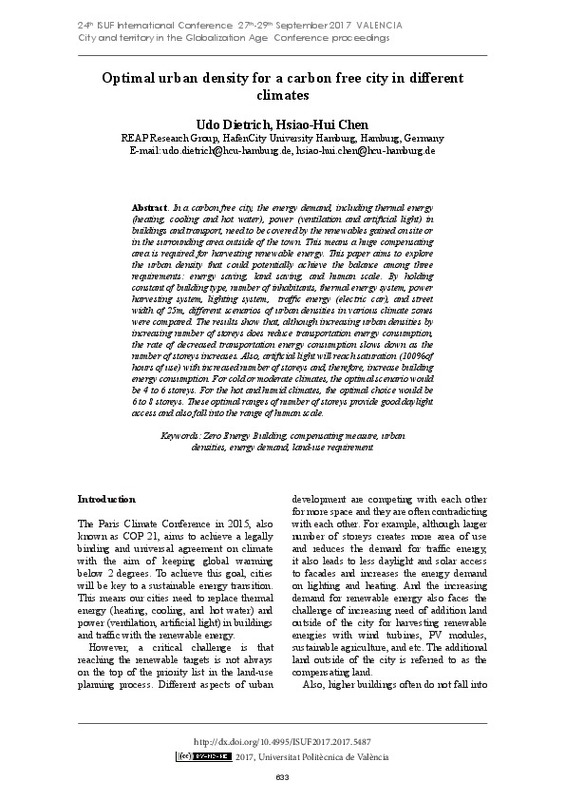JavaScript is disabled for your browser. Some features of this site may not work without it.
Buscar en RiuNet
Listar
Mi cuenta
Estadísticas
Ayuda RiuNet
Admin. UPV
Urban density for a carbon free city in different climates
Mostrar el registro sencillo del ítem
Ficheros en el ítem
| dc.contributor.author | Dietrich, Udo
|
es_ES |
| dc.contributor.author | Chen, Hsiao-Hui
|
es_ES |
| dc.date.accessioned | 2018-12-17T09:06:15Z | |
| dc.date.available | 2018-12-17T09:06:15Z | |
| dc.date.issued | 2018-04-20 | |
| dc.identifier.isbn | 9788490485743 | |
| dc.identifier.uri | http://hdl.handle.net/10251/113897 | |
| dc.description.abstract | [EN] In a carbon free city, the energy demand, including thermal energy (heating, cooling and hot water), power (ventilation and artificial light) in buildings and transport, need to be covered by the renewables gained on site or in the surrounding area outside of the town. This means a huge compensating area is required for harvesting renewable energy. This paper aims to explore the urban density that could potentially achieve the balance among three requirements: energy saving, land saving, and human scale. By holding constant of building type, estate size, thermal energy system, power harvesting system, lighting system and traffic energy (electric car), different scenarios of urban density in various climate zones were compared. The results show that, although increasing urban density by increasing number of storey does reduce transportation energy consumption, the rate of decreased transportation energy consumption slows down as the number of storey increases. Also, artificial light will reach saturation (100% of hours of use) with increased number of storeys and, therefore, increase building energy consumption. For cold or moderate climates, the optimal scenario would be 4 to 6 storeys with street width of 25m. For the hot and humid climates, the optimal choice would be 6 to 8 storeys and the effect of urban density on the land-use requirement is larger than the effect of compensating area because heating is power-based. These optimal ranges of number of storey provide good daylight access and also fall into the range of human scale. | es_ES |
| dc.format.extent | 8 | es_ES |
| dc.language | Inglés | es_ES |
| dc.publisher | Editorial Universitat Politècnica de València | es_ES |
| dc.relation.ispartof | 24th ISUF International Conference. Book of Papers | es_ES |
| dc.rights | Reconocimiento - No comercial - Sin obra derivada (by-nc-nd) | es_ES |
| dc.subject | Zero energy building | es_ES |
| dc.subject | Compensating measure | es_ES |
| dc.subject | Urban densities | es_ES |
| dc.subject | Energy demand | es_ES |
| dc.subject | Land-use requirement | es_ES |
| dc.title | Urban density for a carbon free city in different climates | es_ES |
| dc.type | Capítulo de libro | es_ES |
| dc.type | Comunicación en congreso | es_ES |
| dc.identifier.doi | 10.4995/ISUF2017.2017.5487 | |
| dc.rights.accessRights | Abierto | es_ES |
| dc.description.bibliographicCitation | Dietrich, U.; Chen, H. (2018). Urban density for a carbon free city in different climates. En 24th ISUF International Conference. Book of Papers. Editorial Universitat Politècnica de València. 633-640. https://doi.org/10.4995/ISUF2017.2017.5487 | es_ES |
| dc.description.accrualMethod | OCS | es_ES |
| dc.relation.conferencename | 24th ISUF 2017 - City and Territory in the Globalization Age | es_ES |
| dc.relation.conferencedate | Septiembre 27-29,2017 | es_ES |
| dc.relation.conferenceplace | Valencia, Spain | es_ES |
| dc.relation.publisherversion | http://ocs.editorial.upv.es/index.php/ISUF/ISUF2017/paper/view/5487 | es_ES |
| dc.description.upvformatpinicio | 633 | es_ES |
| dc.description.upvformatpfin | 640 | es_ES |
| dc.type.version | info:eu-repo/semantics/publishedVersion | es_ES |
| dc.relation.pasarela | OCS\5487 | es_ES |








